Sedges
The differences between rushes, sedges and their relatives are described in greater detail on a separate page, which you can visit by clicking here. But in essence, flowers of the sedge family lack the six tepals of the rush family and instead, each flower has a single bract at its base which is known as a glume. These glumes are greenish or brownish (sometimes almost black) in colour and completely conceal the flower, except when the ripe anthers or stigmas just protrude during flowering.
Each flower actually also has a second bract; this second bract may not be apparent as a bract, as it completely surrounds the ovary (and eventually the seed) except for a small hole at the top where the stigmas protrude. This bag-like covering is known as a utricle and the term is usually used to include the entire bract and its enclosed ovary/seed when describing the structure of sedges.
True sedges in the genus Carex have imperfect flowers, so each flower will be either male or female - that is to say, each flower will have either stamens (male flowers) or stigmas (female flowers) but not both. The overall flower spike may have male and female flowers distributed more or less throughout the flower spike, or may have a tendency to have the male flowers towards the top and the female flowers towards the bottom of the spike.
Identification
Features to note when deciding which of the groups listed below that your sedge may belong to include: whether the leaves form tight tussocks, or spreading colonies of vegetation; whether the flowers are all the same in the overall spike, or whether the male and female flowers tend to be separated out into different spikelets; whether the utricles are hairy or smooth (you will need a hand lens for this!); whether the female flowers have two or three stigmas; whether the lowest spikelet of the flower spike is pendulous or not.
The main purpose of this page is to attempt to break this group up into bite-sized chunks, so that the pages you are led to do not get too big by containing a large number of species. At worst, if you follow a link from here and do not see your plant, return to this page and try another link. Remember at this stage that the photos are representative of a group of species and may not look exactly like your plant at this stage, so you should carefully read the text to head you in the right direction.
Use the photos and text below to narrow your search to a group, then click on the picture to go to the next stage.
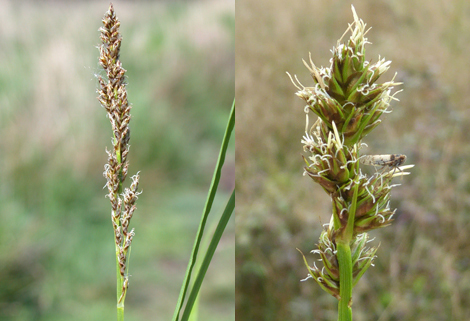 |
Sedge Group 1
The overall flower spike consists of a few to many, smaller spikelets, each made up of several flowers. The spike may be short and congested or may consist of numerous spikelets spaced along the central stalk, but in all cases, the spikelets will appear the same, with male and female flowers present throughout all of the spikelets and with no major difference in size or shape between the lowest and uppermost spikelets. This group has flowers very similar to the plants in Group 2, except Group 1 plants have leaves that form tussocks.
Photos show flower spikes of Greater Tussock Sedge and False Fox Sedge. |
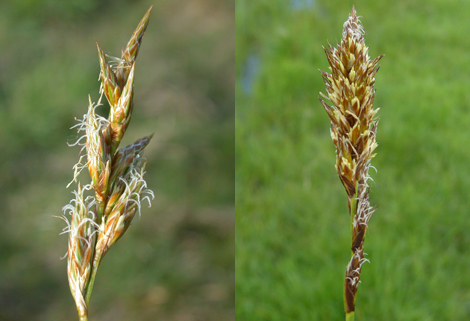 |
Sedge Group 2
As with Group 1, the flower spike may be short and congested or may consist of numerous spikelets spaced along the central stalk, but in all cases, the spikelets will appear the same, with male and female flowers present throughout all of the spikelets and with no major difference in size or shape between the lowest and uppermost spikelets. This group has flowers very similar to the plants in Group 1, except Group 2 plants have leaves that form either small, open tussocks or, more often, form spreading stands of vegetation from creeping rootstocks.
Photos show flower spikes of Sand Sedge and Brown Sedge. |
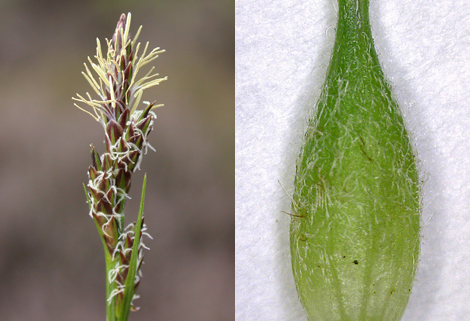 |
Sedge Group 3
The overall flower spike consists of a few to many, smaller spikelets, each made up of several flowers. The spike may be short and congested or may consist of numerous spikelets, well-spaced along the central stalk. In this group, the spikelets clearly differ in appearance from top to bottom, with the male flowers clustered towards the top and the female flowers below. Often, the topmost spikelet will consist entirely of male flowers, while the lowest spikelet will be entirely female. Intermediate spikelets may have a mix of flowers, but with the males tending to be at the end furthest from the central stem. This group differs from all following groups by having hairy utricles.
Photos show flower spike of Pill Sedge and hairy utricle of Hairy Sedge. |
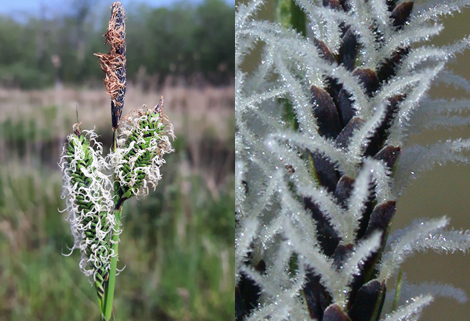 |
Sedge Group 4
The flowers resemble those of Group 3, with the spikelets clearly differing in appearance from top to bottom, the male flowers being clustered towards the top and the female flowers below. Often, the topmost spikelet will consist entirely of male flowers, while the lowest spikelet will be entirely female. Intermediate spikelets may have a mix of flowers, but with the males tending to be at the end furthest from the central stem. This group has hairless utricles and the female flowers have two stigmas. If flowering has finished and the stigmas are gone, the utricle will be seen to be more or less biconvex in cross section (not roundly three-sided).
Photos show late flower spike of Common Tufted Sedge and the paired stigmas of Common Sedge. |
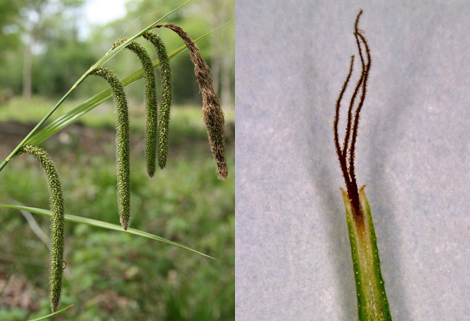 |
Sedge Group 5
In this group, the flowers again resemble those of Group 3, with the spikelets clearly differing in appearance from top to bottom, the male flowers being clustered towards the top and the female flowers below. Often, the topmost spikelet will consist entirely of male flowers, while the lowest spikelet will be entirely female. This group also has hairless utricles, but the female flowers have three stigmas. If flowering has finished and the stigmas are gone, the utricle will be seen to be plump and roundly three-sided in cross section. In Sedge Groups 5 and 6, the lowest flower spikelet (typically all female) will become pendent over time, though note that the spikelet will emerge erect at first, so timing is important. Group 5 sedges have leaves in dense tussocks.
Photos show drooping spikelets of Pendulous Sedge and the triple stigmas on the utricle of Common Wood Sedge. |
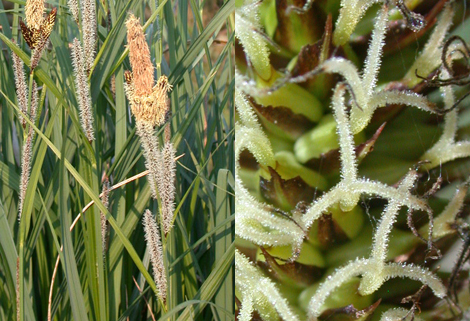 |
Sedge Group 6
In this group, the flowers closely resemble those of Group 5, in all their details with the spikelets differing in appearance from top to bottom, the male flowers being clustered towards the top and the female flowers below, the utricles are hairless and the female flowers have three stigmas. If flowering has finished and the stigmas are gone, the utricle will be seen to be plump and roundly three-sided in cross section. The lowest flower spikelet will become pendent over time, though note that the spikelet will emerge erect at first, so timing is important. However, Group 6 sedges differ from Group 5 in that the leaves do not form dense tussocks but instead form loose, scattered clusters, or form spreading stands of vegetation.
Photos show young, upright lower spikelets that will become more pendulous over time and the triple stigmas of Greater Pond Sedge. |
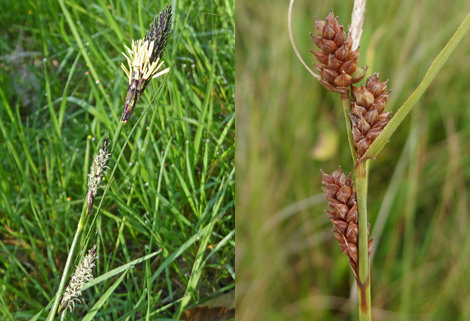 |
Sedge Group 7
The flowers in this group resemble those of Group 5, with the spikelets clearly differing in appearance from top to bottom, the male flowers being clustered towards the top and the female flowers below. Often, the topmost spikelet will consist entirely of male flowers, while the lowest spikelet will be entirely female. This group also has hairless utricles and the female flowers have three stigmas. In Sedge Groups 7 and 8, the lowest flower spikelet will not become pendent over time, but will either remain upright as the fruits ripen, or at best, may project at no more than right angles to the main stem. Note that the entire flower spike may lean heavily to one side from the weight of ripening fruits, but this is not the same as having pendulous lower spikelets. Group 7 sedges have leaves in dense tussocks.
Photos show upright spikelets of Green-ribbed Sedge and the still upright fruiting spike of Long-bracted Sedge. |
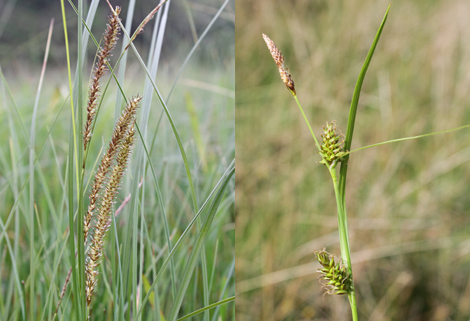 |
Sedge Group 8
The flowers in this group resemble those of Group 7, with the spikelets clearly differing in appearance from top to bottom, the male flowers being clustered towards the top and the female flowers below. Often, the topmost spikelet will consist entirely of male flowers, while the lowest spikelet will be entirely female. This group also has hairless utricles and the female flowers have three stigmas. In Sedge Groups 7 and 8, the lowest flower spikelet will not become pendent over time, but will either remain upright as the fruits ripen, or at best, may project at no more than right angles to the main stem. Note that the entire flower spike may lean heavily to one side from the weight of ripening fruits, but this is not the same as having pendulous lower spikelets. However, Group 8 sedges differ from Group 7 in that the leaves do not form dense tussocks but instead form loose, scattered clusters, or form spreading stands of vegetation.
Photos show upright spikelets of Bottle Sedge and the still upright fruiting spike of Tawny Sedge. |
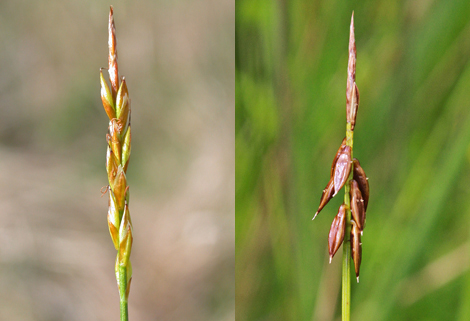 |
Sedge Group 9
This is a small group of sedges that actually consists of just a single species in our area. The sedges in this group differ from those in all other groups by having a flower spike that has all of the flowers arranged as a single spike along the central stem, rather than consisting of two or more clusters of spikelets.
Photos show upright spikelets of Bottle Sedge and the still upright fruiting spike of Tawny Sedge. |